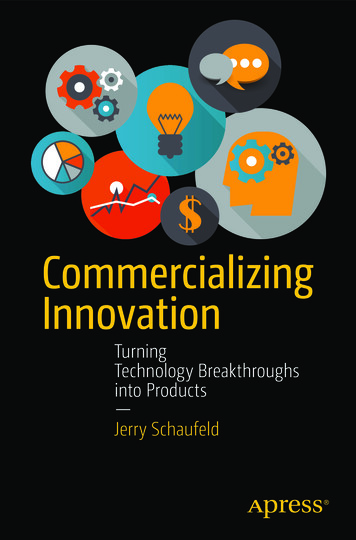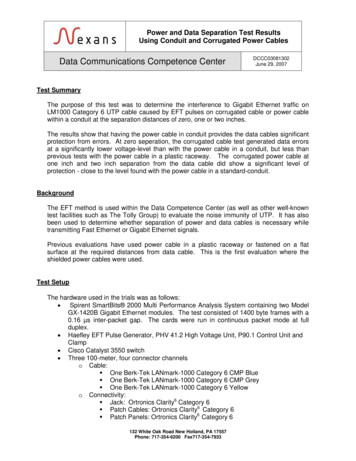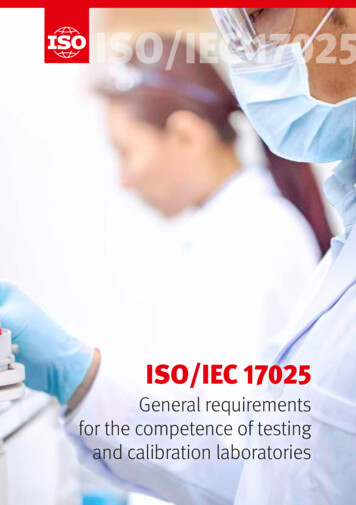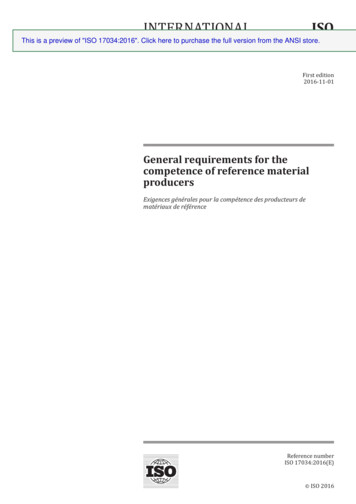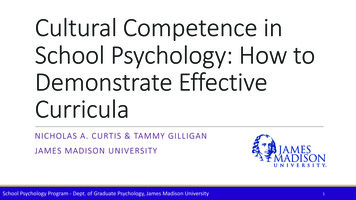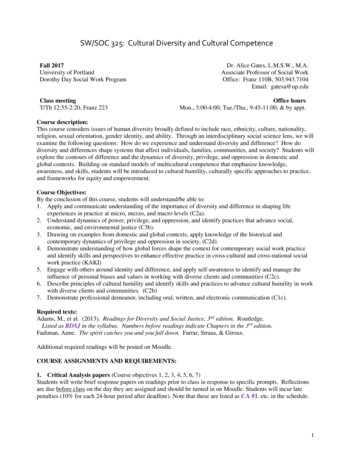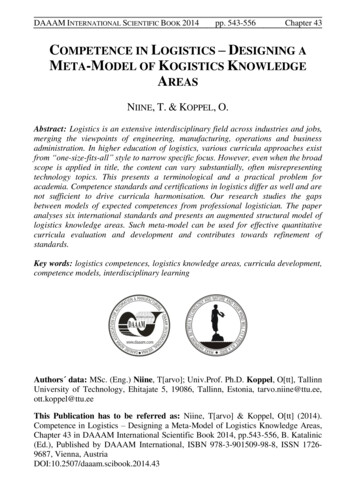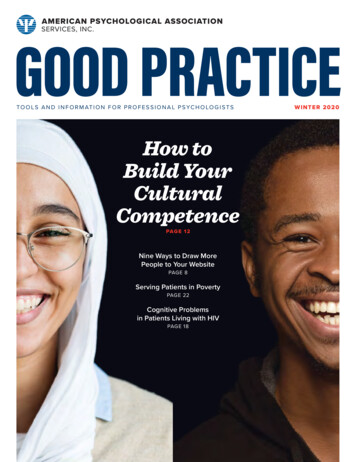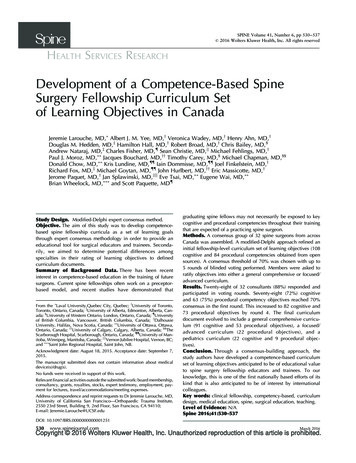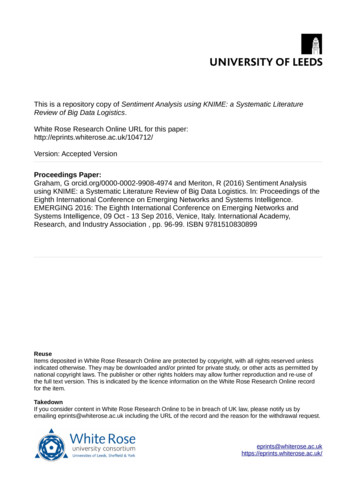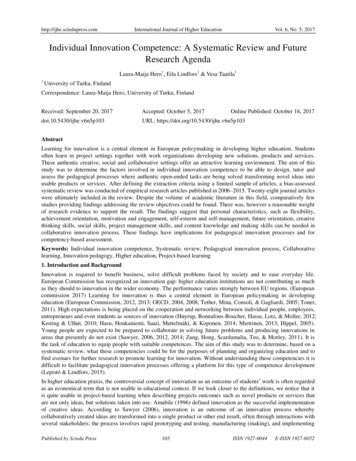
Transcription
http://ijhe.sciedupress.comInternational Journal of Higher EducationVol. 6, No. 5; 2017Individual Innovation Competence: A Systematic Review and FutureResearch AgendaLaura-Maija Hero1, Eila Lindfors1 & Vesa Taatila11University of Turku, FinlandCorrespondence: Laura-Maija Hero, University of Turku, FinlandReceived: September 20, 2017Accepted: October 5, 2017Online Published: October 16, 2017doi:10.5430/ijhe.v6n5p103URL: ing for innovation is a central element in European policymaking in developing higher education. Studentsoften learn in project settings together with work organizations developing new solutions, products and services.These authentic creative, social and collaborative settings offer an attractive learning environment. The aim of thisstudy was to determine the factors involved in individual innovation competence to be able to design, tutor andassess the pedagogical processes where authentic open-ended tasks are being solved transforming novel ideas intousable products or services. After defining the extraction criteria using a limited sample of articles, a bias-assessedsystematic review was conducted of empirical research articles published in 2006–2015. Twenty-eight journal articleswere ultimately included in the review. Despite the volume of academic literature in this field, comparatively fewstudies providing findings addressing the review objectives could be found. There was, however a reasonable weightof research evidence to support the result. The findings suggest that personal characteristics, such as flexibility,achievement orientation, motivation and engagement, self-esteem and self-management, future orientation, creativethinking skills, social skills, project management skills, and content knowledge and making skills can be needed incollaborative innovation process. These findings have implications for pedagogical innovation processes and forcompetency-based assessment.Keywords: Individual innovation competence, Systematic review, Pedagogical innovation process, Collaborativelearning, Innovation pedagogy, Higher education, Project-based learning1. Introduction and BackgroundInnovation is required to benefit business, solve difficult problems faced by society and to ease everyday life.European Commission has recognized an innovation gap: higher education institutions are not contributing as muchas they should to innovation in the wider economy. The performance varies strongly between EU regions. (Europeancommission 2017) Learning for innovation is thus a central element in European policymaking in developingeducation (European Commission, 2012, 2013; OECD, 2004, 2008; Tether, Mina, Consoli, & Gagliardi, 2005; Toner,2011). High expectations is being placed on the cooperation and networking between individual people, employees,entrepreneurs and even students as sources of innovation (Høyrup, Bonnafous-Boucher, Hasse, Lotz, & Moller, 2012;Kesting & Ulhøi, 2010; Hasu, Honkaniemi, Saari, Mattelmäki, & Koponen, 2014; Miettinen, 2013; Hippel, 2005).Young people are expected to be prepared to collaborate in solving future problems and producing innovations inareas that presently do not exist (Sawyer, 2006, 2012, 2014; Zang, Hong, Scardamalia, Teo, & Morley, 2011). It isthe task of education to equip people with suitable competences. The aim of this study was to determine, based on asystematic review, what these competencies could be for the purposes of planning and organizing education and tofind avenues for further research to promote learning for innovation. Without understanding these competencies it isdifficult to facilitate pedagogical innovation processes offering a platform for this type of competence development(Lepistö& Lindfors, 2015).In higher education praxis, the controversial concept of innovation as an outcome of students’ work is often regardedas an economical term that is not usable in educational context. If we look closer to the definitions, we notice that itis quite usable in project-based learning when describing projects outcomes such as novel products or services thatare not only ideas, but solutions taken into use. Amabile (1996) defined innovation as the successful implementationof creative ideas. According to Sawyer (2006), innovation is an outcome of an innovation process wherebycollaboratively created ideas are transformed into a single product or other end result, often through interactions withseveral stakeholders; the process involves rapid prototyping and testing, manufacturing (making), and implementingPublished by Sciedu Press103ISSN 1927-6044E-ISSN 1927-6052
http://ijhe.sciedupress.comInternational Journal of Higher EducationVol. 6, No. 5; 2017the product or service (see also Baregheh, Rowley, & Sambrook, 2009). Innovations are not only technical novelties.Innovations can be any kind of novel products, processes, services or other types of outcomes, but not only ideas orinventions. In this study, an innovation is a novelty made concrete and implemented to convey value. In educationalcontexts, it is often unnecessary to strive primarily for radical innovations (Schumpeter, 1942; Veryzer, 1998) toproduce learning as learning happens during the journey. The authentic innovation project as a learning process canresemble incremental innovation processes. E.g. in higher education contexts students nowadays often learn ininnovative project settings together within a network of industry or other work organizations in authentic creative,social and collaborative settings to transform novel ideas into usable solutions to solve problems. (e.g. Rautkorpi &Hero) These types of authentic innovation processes are often naturally or systematically organised ascross-disciplinary teamwork (Edmondson, 2013; Farrell, 2001). Also in the contexts of basic education studentsshould be able to produce multiple creative solutions to open-ended tasks to develop their competence andinnovativeness in changing circumstances (e.g., Bencze, 2010; Cropley & Cropley, 2010; McLellan & Nicholl,2011). These solutions are also often implemented in practice by providing them into use to bring value in students’surrounding world (Lepistö & Lindfors, 2015). To conclude, a pedagogical innovation process is an authenticinnovation process whereby collaboratively created ideas are transformed into a concrete end result, made concrete,prototyped and tested, and implemented to convey value in the surrounding world through interactions with severalstakeholders (following Sawyer 2006).Although innovation processes benefit from collaboration (John-Steiner, 2000; Sawyer, 2003), new knowledge inreal-life networks can begin with an individual (Nonaka & Takeuchi, 1995). In these pedagogical innovationprocesses students are often judged on how well they perform based on some form of individualised assessment(Sawyer, 2014). However, it is unclear what kind of competencies could develop in these authentic innovationprocesses.The general term competence needs clarification in this context. Competence is the integration and manifestation ofknowledge, skills and attitudes in performance in a specific, pre-defined context and in concrete, authentic tasks(following Mulder, 2012; Mulder & Gulikers, 2011; Sturing, Biemans, Mulder, & De Bruijn, 2011). Thecompetencies needed in innovation processes can refer to knowledge, skills and attitudes (Zhuang, Williamson, &Carter, 1999), but the influence of individual characteristics also seems to be significant (Da Silva & Davis, 2011).Based on these preconditions, individual innovation competence is understood here as a synonym for a set ofpersonal characteristics, knowledge, skills (or abilities) and attitudes that are connected to creating concretised andimplemented novelties via collaboration in complex innovation processes. Similar to other competences, innovationcompetence can be learned and developed (Bruton, 2011; Peschl et al., 2014).Individual perspective to innovation is found to be underrepresented in research (Peschl et al., 2014; Standing et al.,2016). This systematic review aims to contribute to this research gap by seeking answers to the question: What arethe factors of individual innovation competence and possible avenues for future research? This information is likelyimportant for curriculum design and teachers at different educational levels in setting aims and objectives, as well asplanning pedagogical processes and individualised assessment.Many literature reviews have come close to the definitions and research topic of this study. Iddris (2016) sought tounderstand how firms develop their innovation capability to achieve competitive advantage along several dimensions:knowledge management, organisational culture, organisational learning, leadership, collaboration, creativity, ideamanagement and innovation strategy. Mention (2012) identified how intellectual capital affects the innovationprocess, outcomes and performance of companies or firms, but they did not specify competence-related factors of anindividual. Smith, Courvisanos, Tuck and McEachern (2011) examined company learning and development systemsthrough human resource management. These studies investigated innovation capability at the firm or network level,not as individual competence. A study by Timmermans, Van Linge, Van Petegem, Van Rompaey and Denekens(2012) explored the factors that contribute to or hinder team learning in the innovation process, while Standing et al.(2016) focused on the role and actions of individuals in an innovation process setup, not on competence. Thurlingsand Evers’ (2015) study is most similar to the present one. Still, their aim was to unveil teachers’ innovativebehaviour and competence was narrowly understood as skill and knowledge. When considering these review studies,there was no bias-assessed systematic review that would present a more holistic picture of innovation competence.2. Research Design2.1 Systematic Review and Research QuestionThis systematic review aimed to contribute to the identified research gap by seeking answers to the question: Whatare the factors of individual innovation competence based on recent empirical research? The aim was to create anPublished by Sciedu Press104ISSN 1927-6044E-ISSN 1927-6052
http://ijhe.sciedupress.comInternational Journal of Higher EducationVol. 6, No. 5; 2017overview of the individual innovation competence usable in educational settings to promote innovation learning. Thesecondary aim was to find avenues for future research in this important area of cross-disciplinary research. Thus, asystematic review of 2006-2015 published research articles in peer-reviewed, academic journals was conductedusing an explicit method to identify, select and critically appraise relevant research data (see Greenhalgh, 1997;Higgins, 2008; Petticrew & Roberts, 2006). A preliminary search of the term individual innovation competenceyielded no results. However, the concept innovation competence seemed to be used with several meanings. Thesearch criteria and terms were brainstormed among all three authors. The following search terms were used:innovation competenc*, innovativeness, innovation capability/ies, competence to innovate, innovation ability/ies andinnovation skill/s. Synonyms were employed because the term individual innovation competence is not anestablished concept. The Boolean search string TI innovation competence OR TI innovativeness OR TI innovationcapabilit* OR TI competence to innovate OR TI innovation abilit* OR TI innovation skill* was applied.The systematic identification of studies was limited to databases based on their relevance to the field of education.The chosen databases were EBSCO (including ERIC, CINAHL and nine others), PsychINFO (includingProQuest/Education and Psychology) and Scopus. The search was limited to 10 years (2006–2015) to yield areasonable, still adequate sample of peer-reviewed studies.2.2 Inclusion and Exclusion CriteriaThe inclusion and exclusion criteria were first set by thematising a limited sample of the data. Material from theEBSCO databases (limiters peer-reviewed, only 5 years, 2009–2014) was used as a sample (N 524) to determinethe extraction criteria. The initial inclusion criteria was includes definition of innovation competence or its definedsynonyms. When categorising the resulting articles, we found six larger categories of approaches and contexts for theconcept of innovation competence and its synonyms. Most of the articles examined the innovation competence oforganisations (e.g., Kodama & Shibata, 2014; Wang, 2014), country-, region- or area-level innovation capabilities orcompetences (e.g., Chen et al., 2009; DiPietro, 2009) or the innovativeness of non-human things, such as innovativesoftware (e.g., Lim, Moriarty, & Huthwaite, 2011). Consumer innovativeness was used in the context of the diffusionor adoption of novel products or technological goods. In the context of marketing, communication or consumerstudies, individual-level innovativeness was defined e.g. as the ability to adopt, try, buy or accept innovations, and itwas then defined as a person’s ability to understand, receive, socially estimate, spread, implement and useinnovations (e.g., Goswami & Chandra, 2013; Manning, Bearden, & Madden, 1995), but not create them. Extractioncriteria were thus defined as concerning: 1. Organisations (organisation, industry, firm and product programmes); 2.Geographical areas (such as country and region); 3. Non-human entity innovation competence (i.e., animal, product,policy, fashion and marketing); 4. Innovation competence defined as technological device or other new thingadoption (diffusion or adoption of innovation); 5. Publication was not a peer-reviewed academic research journal. 6.Not empirical research. The discipline, or field of research, was not used as exclusion criteria since innovationconcerns many disciplines and paradigms. The inclusion criteria were redefined as 1. Includes the definition ofinnovation and innovation competence or a synonym defined in this study; 2. Concerns individual human beings; and3. Empirically tests factors of innovation competence.Published by Sciedu Press105ISSN 1927-6044E-ISSN 1927-6052
http://ijhe.sciedupress.comInternational Journal of Higher EducationVol. 6, No. 5; 2017Figure 1. Data extraction path (following Moher, Liberati, Tetzlaff, Altman, & The PRISMA Group, 2009).1,448 non-duplicate research articles were found that matched the search criteria (Figure 1). A manual search inspecific innovation-related journals yielded 183 articles; thus, 1,631 articles were subjected to an abstract screeningagainst the extraction criteria. Articles that met the exclusion criteria were extracted. The full text of 264 articles wasreviewed. Of these, 236 were still excluded based on poor quality, vague definitions or poor match to the researchquestion. The authors of two articles were contacted for more information on their research design (Avvisati, Jacotin,& Vincent-Lancrin, 2013; Chell & Athayde, 2011).2.3 Final Material and AnalysisThe final sample consisted of 28 articles that matched the inclusion criteria. Key information from the selectedarticles was defined, including the article title and year, context, study design, study population, subjects and overallrisk-of-bias assessment. (Appendix 1.)The included studies represent the studied phenomenon. Ten of the studies were conducted in an educational context(higher education, secondary or comprehensive education), while 14 occurred in an organisational context(organisational psychology, human resource management or business studies); four studies occurred in both contexts(educational and organisational). Six of the studies were qualitative, 19 were quantitative, and three used mixedmethods. Nine of the studies were case studies, two of which were multiple case studies. The study design andresearch methods varied considerably.The final research data were subject to a three-author bias assessment to make the quality of the material astransparent as possible. A cross-analysis by the three authors was used to avoid possible reviewer subjectivity bias.Each article was individually assessed, considering the following: the methodological rigor in identifying potentialflaws; the generalisability of the study; the strengths and weaknesses caused by research design, conduct, analysisand interpretation of findings; and the validity, reliability, method and sample. The criterion for moderate bias was anarrow cultural sample (e.g., research was conducted in one country only), which had adequate numbers ofinformants and well-reported analyses. A study had medium bias if there was an inadequate sampling of the researchsubjects, a poorly described analytical method or a scope that was too narrow or small to draw conclusions. A studywas considered highly biased if it included several of the aforementioned criteria and the study was inadequatelyreported. The inclusion criteria for the assessment was set to “medium risk of bias”.Published by Sciedu Press106ISSN 1927-6044E-ISSN 1927-6052
http://ijhe.sciedupress.comInternational Journal of Higher EducationVol. 6, No. 5; 2017The analysis was conducted using a data-driven content analysis of the research literature gathered for the systematicreview (following Krippendorff, 2004). The sampling of the chosen material was done by organising the data,evaluating the definition of innovation and extracting the competency factors. Coding was completed by one authorand then, separately as blind review, by the two other authors to limit subjectivity. After several discussions,inter-reviewer agreement reached 100%. The semantic analysis was aimed at exploring the meaning that was derivedfrom the relationships among the concepts in the text (Cohen, Manion, & Morrison, 2007). After coding, thethematization of the subclass and the main classes was conducted by two authors and discussed until agreement wasreached.Finally, the thematization was cross-validated by all three authors against the competence factors of the studiesassessed to contain no risk of bias. The studies with no risk of bias included the large-scale quantitative studies in aneducational context in which the minimum requirement was 200 informants (Avvisati et al., 2013; Lindfors &Hilmola, 2015; Vila, Pérez, & Morillas, 2012) and in an organisational context in which the minimum requirementwas 200 informants (Bjornali & Støren, 2012; Keller, 2012; Montani, Odoardi, & Battistelli, 2014; Vila et al., 2014;Waychal et al., 2011) as well as the qualitative studies with no risk of bias (Chatenier, Verstegen, Biemans, Mulder& Omta, 2010; Chell & Athayde, 2011; Nielsen, 2015).3. ResultsWhen considering the relevance of the articles and their empirical results, the definitions for innovation varied, butwere well in line with each other. In most of the articles, innovation was clearly differentiated from creativity.According to Bruton (2011), a creative product is understood as a novel solution to a problem; once it has beenapplied to a valuable practical application, it becomes an innovation. According to Mathisen, Martinsen and Einarsen(2008), creativity refers to the development of novel and useful ideas and innovations towards the application ofideas. The majority of the articles defined innovation based on outcome. Some of the articles defined innovationaccording to the process. Edwards-Schachter, García-Granero, Sánchez-Barrioluengo, Quesada-Pineda and Amara(2015), Jaiswal and Dhar (2015) and Waychal, Mohanty and Verma (2011) followed Amabile (1996) in defininginnovation as the successful implementation of creative ideas with a subsequent economic and/or social valuegeneration in the market and/or society. According to Vila, Pérez and Coll-Serrano (2014), innovation was theprocess of applying novel ideas and new knowledge to increase the efficiency in the production
The performance varies strongly between EU regions. (European . innovative project settings together within a network of industry or other work organizations in authentic creative, . Many literature reviews have come close to the definitions and
